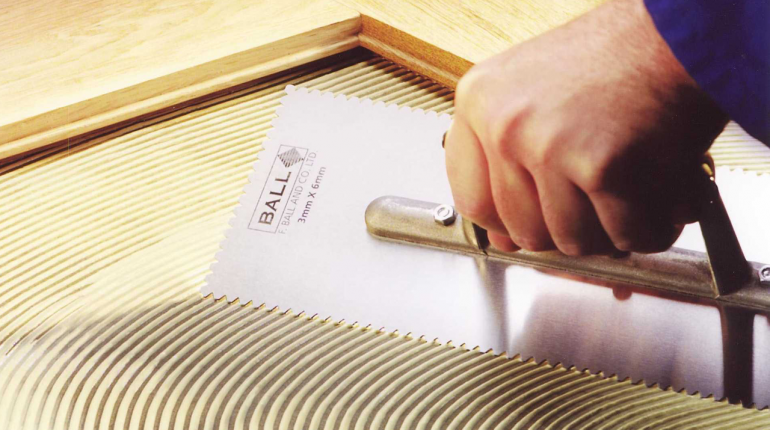Q. What trowel size should I use for applying Styccobond F47?
A. Styccobond F47 is a pressure sensitive adhesive for use with Stopgap Isolator Membrane. Use a 1.5mm x 5mm ‘V’ notched trowel, held at an angle of 60°, to apply the adhesive, then immediately roll with a paint roller wetted with the adhesive. The use of a roller will help reduce drying time and help to obtain a smooth, uniform appearance and minimise adhesive ‘grin through’. Alternatively, you can use a Styccobond fine notch trowel for application. This will extend the drying time of the adhesive. Using the recommended trowel size to apply Styccobond adhesives, held at the correct angle, helps ensure exactly the right amount of adhesive is applied, maximising bond performance and avoiding using too much adhesive.
Q. Can I apply Stopgap 1200 Pro directly to a resin floor without priming first?
A. Yes, you can. However, where underfloor heating is present, it is recommended that you prime using F. Ball’s Stopgap P131 primer or p141 beforehand.
Q. I’m looking for an alternative to a contact adhesive for installing coving in a confined space where vinyl floorcoverings are also being installed.
A. It is recommended that you use Stycco Flex, F. Ball’s solvent-free, hazard-free, rapid-curing flexible tube adhesive. The recently reformulated version of the product is approved for the installation of vertical PVC flooring accessories, such as skirting, capping and coving, due to excellent plasticiser resistance and enhanced dimensional stability. Alternatively, you can use F. Ball’s Styccobond F49 Hybrid PS temperature tolerant vinyl adhesive. Not only is it solvent-free and 100% compatible with PVC flooring accessories, but it only needs to be applied to one surface to achieve a high bond strength, unlike contact adhesives. Plus, with a working time of up to four hours, it allows accessories to be easily repositioned in the initial stages of drying if alignment isn’t correct. You can also use it to install floorcoverings in the area, meaning you only need one adhesive for the project.
Q. What levelling compound should I use in a garage? The customer wants the surface to be painted.
A. Any floor paint can be used over Stopgap 800 once the levelling compound has cured.
Q. Can I apply a levelling compound directly over a calcium sulphate screed, or do I need to apply a primer beforehand?
A. Priming beforehand is always recommended. It stops pinholing, tiny bubbles formed by the slow escape of air from absorbent substrates as they dry, which burst on reaching the surface – leaving small pinholes/craters as the levelling compound cures. Priming also prevents the rapid loss of water from the levelling compound into the substrate, therefore prolonging the open time of the levelling compound. Stopgap P121 is F. Ball’s primer especially formulated to promote the application characteristics of compatible levelling compounds when applied over calcium sulphate screeds. You shouldapply two coats of Stopgap P121; the first coat should be diluted with one part water to one part primer. The second coat should be applied neat.
Q. A customer wants a temporary base to allow carpet tiles or similar floorcoverings to be installed for a short period of time. The original floorcovering cannot be disturbed.
A. Stopgap Isolator Membrane is designed for this sort of situation. It is an impermeable loose-lay sheet designed to provide a barrier for damp subfloors that cannot be prepared by traditional methods because of surface contamination, or for installing temporary floorcoverings where floors need to be returned to their original state, in heritage locations for example. Contractors simply cut the isolator membrane to size, leaving a 3-6mm gap between walls, fixtures, columns and other abutments if excess levels of subfloor moisture are detected. The sheet then provides a sub-base for the installation of a wide variety of vinyl, linoleum and rubber sheet floorcoverings. These can be bonded to the membrane using Styccobond F47 or Styccobond F84 adhesives. The loose-lay system allows the easy removal of floorcoverings when required, leaving the surface below in its original condition.
Our technical team are on standby to answer questions about your projects and F. Ball products from 8.30am – 5.00pm, Monday to Friday.
Please note: site conditions vary. Don’t rely on these specific responses for your own project. If you are unsure about any technical issue relating to specific flooring installations, contact the F. Ball Technical Service team on 01538 361633 or consult the product data sheets available from F. Ball’s website.


